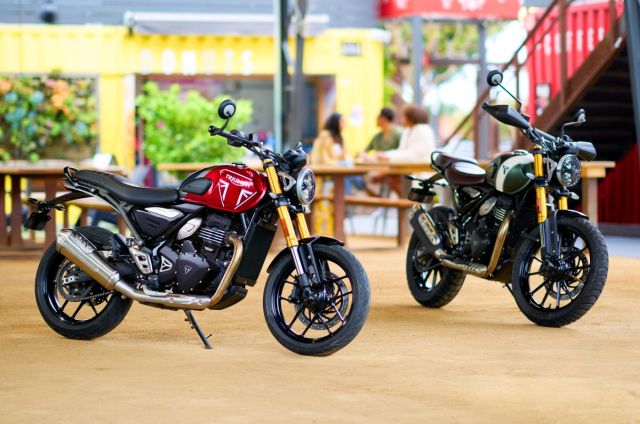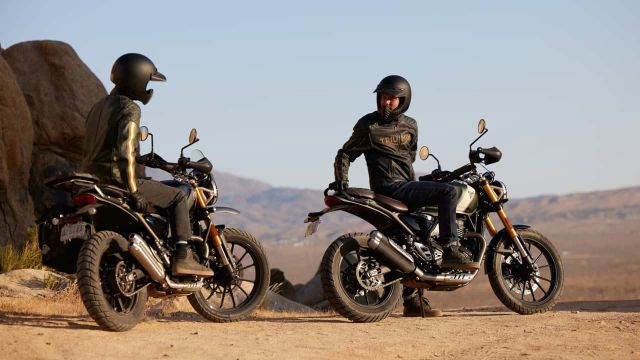Triumph have finally taken the wraps off their 400 twins made in partnership with Bajaj at the official launch in the UK. The newly introduced bikes are called the Speed 400 and Scrambler 400 X. The bikes will be built by Bajaj here in India.

Both motorcycles are powered by an all-new 398-cc, liquid-cooled, single-cylinder four-valve engine that Triumph is calling the TR-series. The DOHC engine is paired with a six-speed gearbox and produces 40 hp and 37.5 Nm of peak torque. Suspension duties on both motorcycles are handled by a 43-mm upside-down (USD) big piston fork and a preload adjustable gas-charged monoshock at the rear. Both bikes feature the same analogue speedometer with an integrated multi-function LCD screen, switchable traction control, LED lighting all around, ride-by-wire throttle, dual-channel ABS, and a slip and assist clutch.
However, the similarities end there as the Speed 400 has a suspension travel of 140 mm and 130 mm (front and back, respectively), whereas the Scrambler 400 X gets a suspension travel of 150 mm at both ends. The Scrambler 400 X also weighs nine kg heavier at 179 kg (dry) compared to the Speed 400’s 170 kg. Next up, the wheelbase measures 1377 mm on the Speed 400 and 1418 mm on the Scrambler 400 X. The Scrambler 400 X also has a taller seat height of 841 mm, while the Speed 400 has a seat height of 798 mm. The trail and rake are also different, with the Speed 400 having a rake angle of 24.6 degrees and a trail of 102 mm, whereas the Scrambler has a rake angle of 23.2 degrees and a trail of 108 mm. When it comes to braking, the Speed 400 features a 300-mm disc at the front and a 230-mm disc at the rear. The Scrambler, however, features a larger 320-mm disc at the front, while the rear remains the same as its roadster twin.

Another difference between the Speed 400 and the Scrambler 400 X is that although both bikes use cast aluminum alloys, the former uses 17-inch alloys wrapped in super-grippy Metzeler Sportec M9RR tires, while the scrambler employs 19-inch alloys shod with Metzeler Karoo Street tires that befit its purpose of going both on and off-road. The Speed 400 gets a 110/70 wheel at the front and a 150/60 rear wheel, in contrast to the Scrambler’s 100/90 front and 140/80 rear wheels. The ABS is also switchable on the Scrambler for off-road use.

Triumph have also done a commendable job in providing distinct styles to differentiate between the models. The Speed 400 boasts a neo-retro design that takes inspiration from the Speed Twin 900 and 1200 models. Its overall aesthetic features clean and flowing design lines, creating a sense of simplicity and elegance. One of the standout design elements is the beautifully sculpted tank, prominently displaying the iconic Triumph logo. This attention-grabbing feature adds a touch of sophistication to the bike while remaining visually pleasing. The Speed 400 is offered in three color options: Carnival Red, Caspian Blue, and Phantom Black.

Meanwhile, the Scrambler 400X adopts a distinct look with the various elements that it comes equipped with to enhance its off-road capability and rugged appearance. These include knuckle guards, a headlight grille, an optional raised fender, a padded handlebar brace, and double-stacked exhausts. The Scrambler 400X also features a large white stripe on the tank, with the Triumph logo placed inside the stripe, which adds a unique visual element. The 400X is offered in several color combinations: Matt Khaki Green and Fusion White, Carnival Red and Phantom Black, and Phantom Black and Silver.

Watch out for our next issue for a review of the Speed 400 and pricing of these much-awaited bikes.
Story: Alshin Thomas
Also read: KTM Europe Adventure Rally Open for Indians


Leave a Reply